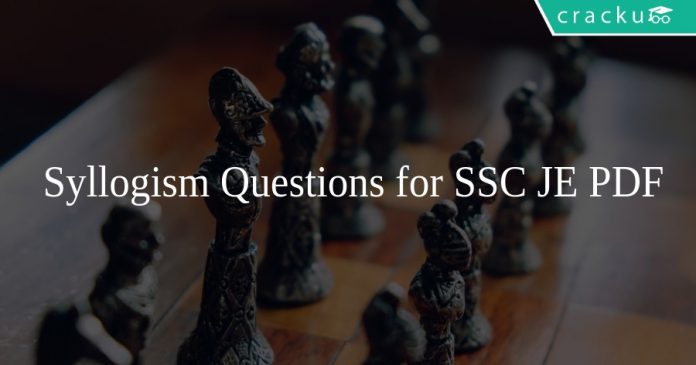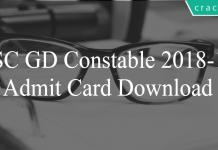Syllogism Questions for SSC JE PDF
Download SSC JE Syllogism Questions PDF. Top 15 SSC JE questions based on asked questions in previous exam papers very important for the SSC exam.
Download Syllogism Questions for SSC JE PDF
Download SSC JE Previous Papers
Instructions
In each of the following questions, one/two statements are given followed by three conclusions. You have to consider the statements to be true even it they seem to be at variance from commonly known facts. You have to decide which of the given conclusions, if any, follow from the given statements.
Question 1: Statements :
Some ladies are beautiful. Some beautifuls are honest. All honest are sensitives.
Conclusion 1 : Some sensitives are beautifuls.
Conclusion 2 : Some honest are ladies.
Conclusion 3 : Some sensitives are ladies.
a) None of the Conclusion follows.
b) Only Conclusion 1 follows.
c) Only Conclusions 1 and 2 follow.
d) All Conclusions follow.
Question 2: In the following question, two statements are given each followed by two conclusions I and II. You have to consider the statements to be true even if they seem to be at variance from commonly known facts. You have to decide which of the given conclusions, if any, follows from the given statements.
Statements:
(I) All shawls are carpets.
(II) No carpet is a pullover.
Conclusion:
(I) No shawls are pullovers.
(II) All carpets are shawls.
a) Conclusion I follows
b) Conclusion II follows
c) Neither I nor II follows
d) Both I and II follows
Question 3: In the following question, two statements are given each followed by two conclusions I and II. You have to consider the statements to be true even if they seem to be at variance from commonly known facts. You have to decide which of the given conclusions, if any, follows from the given statements.
Statements:
(I) Some scooters are trucks.
(II) All trucks are trains.
Conclusion:
(I) Some scooters are trains.
(II) No truck is a scooter.
a) Conclusion I follows
b) Conclusion II follows
c) Neither I nor II follows
d) Both I and II follows
Question 4: In the following question, two statements are given each followed by two conclusions I and II. You have to consider the statement to be true even if they seem to be at variance from commonly known facts. You have to decide which of the given conclusions, if any, follows from the given statements.
Statements:
(I) Some books are toys.
(II) No toy is red.
Conclusion:
(I) Some books are red.
(II) Some toys are books.
a) Conclusion I follows
b) Conclusion II follows
c) Neither I nor II follows
d) Both I and II follows
Question 5: In the following question, two statements are given each followed by two conclusions I and II. You have to consider the statements to be true even if they seem to be at variance from commonly known facts. You have to decide which of the given conclusions, if any, follows from the given statements.
Statements:
(I) All dogs are rats.
(II) Some rats are lizards.
Conclusion:
(I) Some dogs are lizards.
(II) Some lizards are dogs.
a) Conclusion I follows
b) Conclusion II follows
c) Neither I nor II follows
d) Both I and II follows
Question 6: In the following question, two statements are given each followed by two conclusions I and II. You have to consider the statements to be true even if they seem to be at variance from commonly known facts. You have to decide which of the given conclusions, if any, follows from the given statements.
Statements:
(I) All flowers are stems.
(II) All stems are roots.
Conclusion:
(I) All roots are flowers.
(II) All stems are flowers.
a) Conclusion I follows
b) Conclusion II follows
c) Neither I nor II follows
d) Both I and II follows
Question 7: In the following question, two statements are given each followed by two conclusions I and II. You have to consider the statements to be true even if they seem to be at variance from commonly known facts. You have to decide which of the given conclusions, if any, follows from the given statements.
Statements:
(I) Some bags are hot.
(II) All hot things are cakes.
Conclusion:
(I) All cakes are bags.
(II) All bags are cakes.
a) Conclusion I follows
b) Conclusion II follows
c) Neither I nor II follows
d) Both I and II follows
Question 8: In the following question, two statements are given each followed by two conclusions I and II. You have to consider the statements to be true even if they seem to be at variance from commonly known facts. You have to decide which of the given conclusions, if any, follows from the given statements.
Statements:
(I) All pilots are brave men.
(II) All astronauts are pilots.
Conclusion:
(I) All astronauts are brave men.
(II) Some pilots are astronauts.
a) Conclusion I follows
b) Conclusion II follows
c) Neither I nor II follows
d) Both I and II follows
Question 9: In the following question, two statements are given each followed by two conclusions I and II. You have to consider the statements to be true even if they seem to be at variance from commonly known facts. You have to decide which of the given conclusions, if any, follows from the given statements.
Statements:
(I) All dogs are bullocks.
(II) All bullocks are goats.
Conclusion:
(I) All dogs are goats.
(II) All goats are dogs.
a) Conclusion I follows
b) Conclusion II follows
c) Neither I nor II follows
d) Both I and II follows
Question 10: In the following question, two statements are given each followed by two conclusions I and II. You have to consider the statements to be true even if they seem to be at variance from commonly known facts. You have to decide which of the given conclusions, if any, follows from the given statements.
Statements:
(I) Most crops are machines.
(II) Some machines are fools.
Conclusion:
(I) Some fools are machines.
(II) Some crops are fools.
a) Conclusion I follows
b) Conclusion II follows
c) Neither I nor II follows
d) Both I and II follows
Question 11: In the following question, two statements are given each followed by two conclusions I and II. You have to consider the statements to be true even if they seem to be at variance from commonly known facts. You have to decide which of the given conclusions, if any, follows from the given statements.
Statements :
(I) Some camels are ships.
(II) No ship is a boat.
Conclusion :
(I) Some ships are camels.
(II) Some camels are not boats.
a) Conclusion I follows
b) Conclusion II follows
c) Neither I nor II follows
d) Both I and II follows
Question 12: In the following question, two statements are given each followed by two conclusions I and II. You have to consider the statements to be true even if they seem to be at variance from commonly known facts. You have to decide which of the given conclusions, if any, follows from the given statements.
Statements:
(I) All fans are cups.
(II) All cups are pillows.
Conclusion:
(I) All fans are pillows.
(II) All pillows are fans.
a) Conclusion I follows
b) Conclusion II follows
c) Neither I nor II follows
d) Both I and II follows
Question 13: In the following question, two statements are given each followed by two conclusions I and II. You have to consider the statements to be true even if they seem to be at variance from commonly known facts. You have to decide which of the given conclusions, if any, follows from the given statements.
Statement:
(I) Some authors are teachers.
(II) No teacher is a lady.
Conclusions:
(I) Some teachers are not ladies.
(II) Some authors are not teachers.
a) Conclusion I follows
b) Conclusion II follows
c) Neither I nor II follows
d) Both I and II follows
Question 14: In the following question, two statements are given each followed by two conclusions I and II. You have to consider the statements to be true even if they seem to be at variance from commonly known facts. You have to decide which of the given conclusions, if any, follows from the given statements.
Statement:
(I) No women can vote.
(II) Some women are politicians.
Conclusions:
(I) Male politicians can vote.
(II) Some politicians can vote.
a) Conclusion I follows
b) Conclusion II follows
c) Neither I nor II follows
d) Both I and II follows
Question 15: In the following question, two statements are given each followed by two conclusions I and II. You have to consider the statements to be true even if they seem to be at variance from commonly known facts. You have to decide which of the given conclusions, if any, follows from the given statements.
Statements:
(I) All paper are files.
(II) Some files are pens.
Conclusion:
(I) No paper is a pen.
(II) Some papers are pens.
a) Conclusion I follows
b) Conclusion II follows
c) Neither I nor II follows
d) Both I and II follows
Download RRB JE Previous Papers
Answers & Solutions:
1) Answer (B)

Clearly, some sensitives are definitely beautiful. Some honest may or may not be ladies. Similarly, some sensitive may or may not be ladies.
Thus, only Conclusion 1 follows.
=> Ans – (B)
2) Answer (A)
The venn diagram for above statements is :

Conclusion:
(I) No shawls are pullovers = true
(II) All carpets are shawls = false
Thus, only conclusion I follows
=> Ans – (A)
3) Answer (A)
The venn diagram for above statements is :

Conclusion:
(I) Some scooters are trains = true
(II) No truck is a scooter = false
Thus, only conclusion I follows.
=> Ans – (A)
4) Answer (B)
The venn diagram for above statements is :

Conclusion:
(I) Some books are red = false
(II) Some toys are books = true
Thus, only conclusion II follows
=> Ans – (B)
5) Answer (C)
The venn diagram for above statements is :

Conclusion:
(I) Some dogs are lizards = false
(II) Some lizards are dogs = false
Thus, neither I nor II follows
=> Ans – (C)
6) Answer (C)
The venn diagram for above statements is :
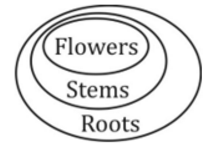
Conclusion:
(I) All roots are flowers = false
(II) All stems are flowers = false
Thus, neither I nor II follows
=> Ans – (C)
7) Answer (C)
The venn diagram for above statements is :
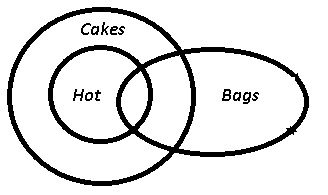
Conclusion:
(I) All cakes are bags = false
(II) All bags are cakes = false
Thus, neither I nor II follows
=> Ans – (C)
8) Answer (D)
The venn diagram for above statements is :
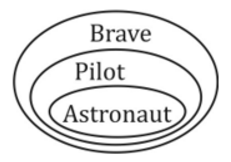
Conclusion:
(I) All astronauts are brave men = true
(II) Some pilots are astronauts = true
Thus, both I and II follows
=> Ans – (D)
9) Answer (A)
The venn diagram for above statements is :
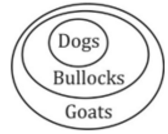
Conclusion:
(I) All dogs are goats = true
(II) All goats are dogs = false
Thus, only conclusion I follows
=> Ans – (A)
10) Answer (A)
The venn diagram for above statements is :
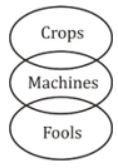
Conclusion:
(I) Some fools are machines = true
(II) Some crops are fools = false
Thus, only conclusion I follows
=> Ans – (A)
11) Answer (D)
The venn diagram for above statements is :

Conclusion :
(I) Some ships are camels = true
(II) Some camels are not boats = true
Thus, both I and II follows
=> Ans – (D)
12) Answer (A)
The venn diagram for above statements is :
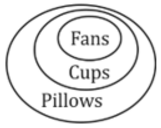
Conclusion:
(I) All fans are pillows = true
(II) All pillows are fans = false
Thus, only conclusion I follows
=> Ans – (A)
13) Answer (A)
The venn diagram for above statements is :

Conclusions:
(I) Some teachers are not ladies = true
(II) Some authors are not teachers = false
Thus, only conclusion I follows.
=> Ans – (A)
14) Answer (C)
15) Answer (C)
The venn diagram for above statements is :

Conclusion:
(I) No paper is a pen = may or may not be true
(II) Some papers are pens = may or may not be true
Thus, neither I nor II follows
=> Ans – (C)
Download SSC JE Previous Papers
We hope this Syllogism Questions pdf for SSC JE exam will be highly useful for your Preparation.


